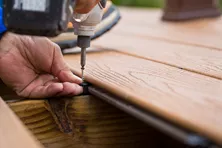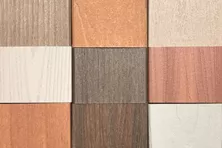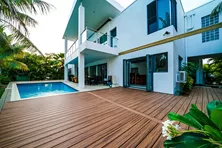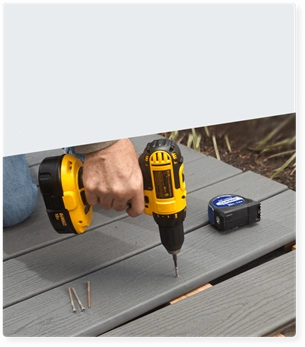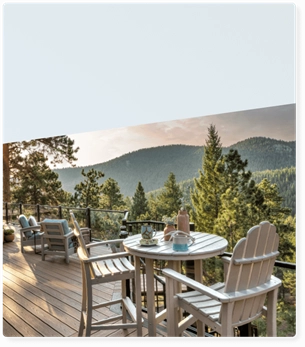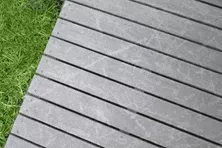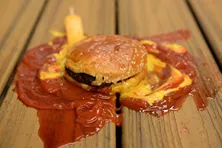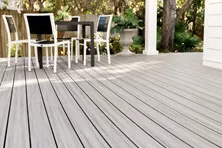As an Amazon Associate, Decks.com earns from qualifying purchases from the links in this post.
Preventing & Treating a Slippery Deck
A deck is an extension of your living space. When the weather is nice, your deck becomes a hub of activity, the perfect place to entertain friends and family outdoors. The last thing you want is for your deck to be unsafe, which is why a slippery deck can be a problem.
Why is My Deck Slippery?
Over the changing seasons, leaves and debris will accumulate on your deck. This may seem harmless at first, but the longer you wait to clear debris off your deck, the longer moisture will stick around, providing the conditions for mold, mildew, algae and moss to grow and cause a slippery deck surface.
If you live in a moist climate or your deck is shaded, these factors will expedite the growth of these organisms, as they thrive in a damp, dark environment. Even the buildup of pollen and other debris can create a slippery surface when moisture is present.
Whether your deck is made of natural wood or composite decking material, each can be just as slippery as the other under the conditions described above. While composite decks are built to last longer than natural wood decks, their surfaces aren’t impervious to mold and moss and the slipperiness that comes with them.
Preventing Your Deck from Becoming Slippery
The best strategy for a slip-resistant deck surface, whether made of wood or composite material, is to perform routine cleaning and maintenance.
Sweep and Clear Debris
Promptly sweeping leaves from your deck – particularly after storms and rain – will prevent the buildup of moisture on the deck surface and the growth of mold, mildew, and algae. You can also clear debris from cracks and gaps between boards with a putty knife or similar flat edge to halt moisture and organism growth.
Clean your Deck Annually
This is perhaps the most important step in preventing a slippery deck surface. A thorough cleaning each year, ideally with a pressure washer, will allow the natural wood grain (or simulated wood grain on composite decks) to provide extra traction and slip-resistance.
You can buy commercially available cleaning solutions or create your own by mixing ⅓ cup of powdered laundry detergent (ammonia-free), 1-quart of bleach and 3 gallons of water. Use a broad fanning nozzle with the power washer to avoid causing damage to paint or wood stain.
If a power washer is not available, a wet-mop or pump sprayer will also get the job done. Apply the cleaning solution and allow it to sit for 15 minutes. Afterwards, scrub the deck boards with a scrub brush attached to a wood or broom handle (this makes the process much easier and faster). Finish by thoroughly rinsing with a hose and then allowing it to dry.
Apply Anti-Slip Products
Lastly, if you’re looking for a little extra slip resistance for high traffic areas, steps or other areas of concern, consider a marine grade anti-slip product, such as Rust-Oleum Marine Anti-Slip Additive. This and similar anti-slip products typically contain either sand or aggregates that are mixed into paint or resin to provide extra traction. You may also consider applying self-adhesive strips of coarse grit, which feels like a very light grade of sandpaper.
This page contains affiliate links. If you choose to purchase after clicking a link, Decks.com may receive a commission at no extra cost to you.
How to Clean Outdoor Patio Cushions
Keeping your outdoor furniture cushions clean helps extend their life and makes your deck or patio area look nice. Learn how to clean outdoor cushions.
How to Replace Deck Boards & Repair Your Deck
Deck boards can split, rot or come loose over time, but it’s easy to remove and replace deck boards without rebuilding the whole deck. Learn how from the experts at Deck.com.
Capped Composite Decking
What is capped composite decking? It's a great option if you like the look of wood but not the maintenance. Learn about capped composite at Decks.com.
Pool Decking Options
When choosing a pool deck material, you should consider slip-resistance, heat absorption and more. Find the best material for your pool deck with Decks.com.
Evergrain
Evergrain composite decking is manufactured by Epoch Composite Products in Lamar, MO.
More Helpful Resources
Explore Articles by Topic

Footings
Information related to installing frost footings for decks

Framing
Learn structural framing methods

Decking
Learn about wood and composite decking materials

Stairs
An in-depth look at the complex issue of how to build stairs

Railings
How to install guardrails and handrails to meet IRC code

Features
An overview on water drainage, benches, planters and lights

Design
The basics of deck design

Planning
Learn about permits and working with contractors

Porches & Patios
Build a covered deck to enjoy all seasons

Ledger
Proper attachment techniques

Care
Maintain your deck to maintain your investment

Materials
An overview on water drainage, benches, planters and lights
How to Remove Scuffs and Scratches from Composite Decking
Removing scuffs and scratches can help make your composite deck look like new. Learn how to fix and prevent your composite deck from future scratches.
Deck Maintenance Checklist
Wondering how to best care for your deck? Download our comprehensive deck maintenance checklist to ensure your deck is safe and lasts for years at Decks.com.
Best Deck Cleaner Options
Discover the best deck cleaning and brightening solutions for composite decks, wood decks, and more. Learn how to remove dirt, mildew, and algae with Decks.com.
Is Trex Decking Worth the Investment? Expert Insights and Reviews
Discover why Trex decking is worth the investment. Learn about its durability, low maintenance, eco-friendliness, and the long-term value it adds to your home.
Differences Between PVC & Composite Decking
Both PVC and composite materials can be a great alternative to traditional wood decking. Learn the pros and cons of each material with our full comparison.
Pool Decking Options
When choosing a pool deck material, you should consider slip-resistance, heat absorption and more. Find the best material for your pool deck with Decks.com.
Explore Articles by Topic

Footings
Information related to installing frost footings for decks

Framing
Learn structural framing methods

Decking
Learn about wood and composite decking materials

Stairs
An in-depth look at the complex issue of how to build stairs

Railings
How to install guardrails and handrails to meet IRC code

Features
An overview on water drainage, benches, planters and lights

Design
The basics of deck design

Planning
Learn about permits and working with contractors

Porches & Patios
Build a covered deck to enjoy all seasons

Ledger
Proper attachment techniques

Care
Maintain your deck to maintain your investment

Materials
An overview on water drainage, benches, planters and lights






